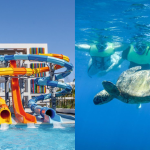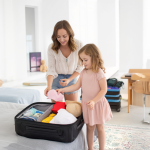Going on a family trip to Europe can be like opening up a treasure trove filled with fascinating things to uncover and experience. From Parisian avenues to Rome’s breathtaking sites, Europe provides the chance for travelers to immerse themselves in foreign cultures while learning something new about them all at the same time. However, all of its cobblestone alleyways and majestic sites can make planning the ideal vacation difficult if everyone in your group wants different things from it all!

Fear not! This guide is your compass through the labyrinth of planning, ensuring your family’s European escapade is not only exhilarating but also effortlessly enjoyable. It’s best to be thorough yet efficient when planning your family trip to Europe. Begin by breaking your task into smaller parts, complete each section, and proceed to the next one before reviewing for perfection.
These are the steps we find work best:
1. Setting A Budget
Budget planning is at the core of any successful trip. While Europe can be costly, with proper preparation, you can control costs effectively and enjoy every moment.
Consideration While Setting a Budget
Flights:
Look for deals and book early. Use fare comparison websites and consider flying into less popular airports to save money. Booking round-trip tickets to and from a single airport could save money; however, this may not always be possible.
Accommodation:
Check options range from luxury hotels to budget hostels. Renting apartments through Airbnb might be a good deal if you are looking for an extra space with a cooking facility.
Transportation:
Trains, buses, and low-cost airlines are the direct modes of journey. If you plan to travel by train, investigate rail passes.
Food:
Eating out can add up. Opt for local markets and grocery stores to save money on meals.
Activities:
Research and book popular attractions in advance to avoid long lines and often save on entry fees.
2. Choosing Destinations
According to the United Nations, there are 44 countries in Europe today. Now, how do you choose which ones (if any) and where to visit each one(s)?
That is a question that only you can answer. Which nation or countries have always piqued your curiosity? The amount of things Europe offers makes choosing where and when to go challenging. List everything you want to see, rank it, and then arrange your trip to fit it all in!

Most Traveled to with Families:
- Paris, France: For a truly remarkable experience, see Disneyland Paris, the Louvre Museum, and the Eiffel Tower.
- London, United Kingdom: Before an exclusive Harry Potter studio tour, see the Natural History Museum and the Tower of London!
- Plan a Trip to Rome, Italy, to sample real Italian food while seeing the Vatican Museums and Colosseum.
- In Barcelona, Spain, arrange a time to visit Park Guell, Montjuic’s Magic Fountain, and picturesque beaches.
- When you are in Amsterdam, Netherlands, take canal cruises, bicycle rides, and tours of the Anne Frank House.
3. Creating an Itinerary
Where do you want to go? This is an enormous first question! Answering this question involves many considerations, and planning is critical to making the most of your time away. A well-prepared itinerary ensures you make the most of every moment without feeling pressured. Remember to balance sightseeing activities with downtime if traveling with young children.
Staying for as long as possible allows for jet lag recovery, meeting new people, and exploring all Europe offers. So plan to go as long as possible, and use every moment wisely!
Tips for Itinerary Planning:
- Prioritize Must-Sees: List the top attractions and experiences each family member wants.
- Include Rest Days: Plan for relaxation and free time to avoid burnout.
- Be Flexible: Leave room for spontaneous activities and discoveries.
- Consider Travel Time: Factor in the time needed to travel between destinations.
4. Booking Accommodations
You can start booking your accommodations once you know your European route and timeline. Again, there are lots of things to consider. How many are traveling together? Would a luxury hotel be your choice of lodging? Select lodging where you may interact with the people and learn about European culture.
Once you find a property that meets all your specifications, try booking directly with them to secure better rates or to take advantage of special packages, like breakfast included. Booking directly vs. paying a commission to someone else also helps support their local economies!
Accommodation Types:
- Hotels: Many offer family rooms and amenities such as pools and kid-friendly dining.
- Vacation Rentals: Apartments or houses provide more space and kitchen facilities, ideal for longer stays.
- Hostels: Family rooms and budget-friendly prices make hostels a viable option.
- All-Inclusive Resorts: These can be convenient, offering activities and meals in one package.
Tips for Choosing Accommodations:
- Location: Try to Stay nearby to famous attractions or public transportation for easy convenience.
- Amenities: Search for stays with family-oriented amenities like cribs, high chairs, and gaming areas.
- Reviews: Read reviews from other families to gauge suitability.
5. Preparing for Travel
You know what is fundamental to a hassle-free journey: Preparation. So, make sure you have all the necessary documents with you.
Important Documents:
- Passports: Check expiration dates and obtain visas if required.
- Travel Insurance: Cover medical emergencies, trip cancellations, and lost luggage.
- Copies of Important Documents: Keep copies of passports, tickets, and reservations.
Packing Tips:
- Clothing: Pack versatile outfits suitable for the weather and planned activities. Consider family-matching clothes for fun and memorable vacation photos.
- Essentials: Bring necessary medications, toiletries, and a first-aid kit.
- Entertainment: Pack books, games, and devices to entertain children during travel.
6. Health and Safety
Ensuring the health and safety of your family is paramount. Take necessary precautions and be aware of local regulations.
Health Precautions:
- Vaccinations: Before the journey, Ensure all family members have received routine vaccinations. Check if any additional vaccines are required for your destinations.
- Medical Kit: Include basic first aid supplies and any prescription medications.
- Health Insurance: Confirm coverage abroad or purchase travel health insurance.
Safety Tips:
- People to Call in an Emergency: Know the local emergency numbers and the address of the nearest embassy or consulate.
- Child safety: Put ID bands on young children and organize a meeting point in case they become separated.
- Learn about the local rules and laws: Before visiting a new location, it is prudent to learn about its regulations and procedures.
7. Enjoying Family-Friendly Activities
Research, research, research! Go to all the “must-see” sights.
Europe offers a plethora of activities suitable for families. Engage in a mix of educational, recreational, and cultural experiences. Get a guide when that is important. Check to ensure the museums you want to see are open on the days you’ll be there! Know opening times long before you arrive.
Remember, If you are traveling with a family with young children, you will want a different guide.

Top Family Activities:
- Museums and Educational Sites: Many European cities have interactive museums and historical sites that engage children.
- Parks and Outdoor Spaces: Spend time in parks, gardens, and nature reserves. Cities like London and Paris have beautiful green spaces perfect for picnics and play.
- Adventure Parks and Zoos: Visit theme parks, zoos, and aquariums for a fun-filled day.
- Cultural Experiences: Attend local festivals, theater performances, and workshops to immerse in the local culture.
8. Navigating Europe with Kids
Choose your transportation wisely based on your comfort level and your budget. If you’re considering renting a car and returning it to a different country, additional fees may be involved.
Exploring the continent through train travel in Europe is an excellent option, although it may have a slightly higher price tag than budget airlines like Ryanair or EasyJet.
If you are taking a ferry, check on the times and pre-book as necessary. If you hire drivers to transfer you from one place to another, request an English-speaking driver if that is important to you. Below are some additional tips:
Transportation Tips:
- Public Transport: Use buses, trams, and trains, which are often child-friendly and offer discounted fares for families.
- Car Rentals: Consider renting a car for flexibility, especially in rural areas.
- Strollers and Car Seats: Check policies for bringing strollers and car seats. Some rentals and airlines provide them.
Managing Expectations:
- Patience: Allow extra time, from getting ready in the morning to moving through airport security.
- Engagement: Keep children engaged with stories about destinations and games and involve them in planning.
9. Making Memories

Finally, a family trip to Europe is about creating lasting memories. Capture these moments to cherish for years to come.
Tips for Making Memories:
- Photographs and Videos: Take plenty of pictures and videos. Consider family-matching clothes for coordinated and fun vacation photos. Websites like PatPat offer various adorable and stylish matching outfits for families.
- Journals and Scrapbooks: Encourage children to keep a travel journal or scrapbook to document their experiences.
- Souvenirs: Collect small souvenirs from each destination as keepsakes.
Conclusion
Planning a family trip to Europe takes careful thought. Still, its rewards can be unforgettable: cultural enrichment and family bonding are assured with proper budgeting, selection of suitable destinations, crafting an exciting itinerary, and taking necessary health and safety precautions. And don’t forget to bring plenty of photos as keepsakes along the way—remember to have a safe journey and keep taking plenty of photos as keepsakes! Happy travels! Bon voyage!
















Leave a Reply